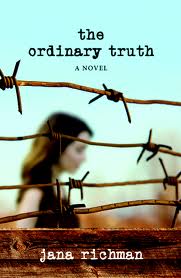As with this country of ours at large, there is at play, in Jana Richman’s new novel The Ordinary Truth (Torrey House Press, 2012), the national see-saw of delusions vs. reality, collective doctrines vs. the sweet, inevitable flux of life’s authentic rhythms. In central Nevada—the driest state in the union, where this contemporary western takes place—authentic, inevitable life is rooted in the land and made possible by that rarest of west desert commodities: water.
Here’s a little tutorial for all of you water-rich east coasters. It’s given early in the book by Kate, the middle-aged Deputy Water Resource Manager: “You can mess with the rancher’s daughter and get away with it. You might even be able to mess with the rancher’s wife and still come out okay. But you mess with the rancher’s water, you can’t expect to just waltz into town one day, unarmed and unprotected. That you’re damn sure not going to get away with.”
Here Kate is talking to her young, live-in boyfriend, a pony-tailed, tantric sex-practicing urbanite who is wondering why she’s so estranged from her rancher family 400-plus miles north of where they live, and work, in Las Vegas high rises. Like the tiny but life-sucking island of Manhattan supported by its outlying boroughs, Vegas is a water-sucking desert island supported by drainage of deep carbonate aquifers that the sparsely-populated ranching communities up north rely on for survival.
And Kate is the point person in the Nevada Water Authority’s actual proposal to spend $2 Billion burying a 300-mile water pipe to drain 200,000 acre feet of water a year from six basins and send it back to the hoards walking The Strip. So she isn’t going to be “waltzing” into her home town of Omer Springs if she can help it. Meanwhile, as she compartmentalizes her rural heritage from her work, the cognitive dissonance is starting to fray her around the edges. There seems to be something more dangerous to Kate in Spring Valley than the machinations of a water grab that for the denizens of Vegas will, as she says, “secure the future of their oblivion.” (p. 315)
In one word, the danger is her irascible, 70-something-year-old mother Nell. Told through alternating first-person accounts, including Kate’s, The Ordinary Truth is, at 368 pages, a big, grappling work of intense rural family dramas, the receding life of western ranching, the threat of unsustainable urban sprawl and, literally, a smoking gun. It’s got everything you might imagine should be in a western—big sweaty men and strong women who talk in vernacular; horses and a dog named Jasper distinguished by their personified temperaments; tightly sprung barbed wire fences; ranch hands who drift in one day and stay 20 years; long drives over hill and vale to get to the public school and the occasional trip into Ely for a steak dinner at The Nevada.
But Richman, whose second book and first novel The Last Cowgirl was set in nearby Utah and also explored both the clash of the cowboy myth with the suburban/urban climes (where most westerners now have gathered) as well as the way technologies shape (and threaten) the land, among other things, has written more than a genre novel here. After all, this is Nevada, where not only live the improbable cities of Vegas and Reno but where bumping along in a truck cab, spewing dust for hundreds of miles along the placarded “loneliest highway in America” is de rigeur, but where atomic bombs are tested and brothels are happily regulated by the state.
In fact, it’s in one of these brothels, outside the state’s capital where Kate’s college-aged daughter Cassie is holed up. She’s the catalyst of this tale, having convinced both her grandma Nell and her mother Kate, locked in a 36-year feud, that she’s living with the other for the summer. Unlike her best friend from college who got them both summer jobs at the Wild Filly Stables, Cassie has found her niche away from the back rooms at a computer designing the website. But like her mother, she is haunted by Spring Valley. “They’re all the people I love in the world,” she explains. “I feel like I walked into the last scene of the last act of a play. I’m not expecting I can turn this into a happy ending, but….I have to try anyway.” Ever since Nell’s husband (and Kate’s father) Henry Jorgensen died in a mysterious hunting accident, mother and daughter have moved further apart. Like the missing father in Tennessee Williams’ The Glass Menagerie, Henry presence is all too felt in the cast of characters that includes Nell’s twin brother Nate, his wife Ona and most of the town of Omer Springs. Nothing has been okay since Henry died, with mother and daughter competing for his love in absentia rather than being drawn together by their mutual calamity.
We learn later that ordinary truth, not the insipid lionizing found in an obituary, must come out, and the novel for the most part successfully navigates the various voices from which we learn, piecemeal, what went wrong in Omer Springs. Even the hazy romanticism that Henry inhabits in everyone’s head is brought into question, although not as much as I would have liked. Additionally, Richman occasionally overreaches, stating the obvious as when one of her characters points out the terrain of an entire family history mapped out in a facial scar. Yet, in the end she admirably wrangles with a story that elevates itself into a kind classic Greek tragedy but with spurs.
And as in the best dramas, she is sure-footed in sympathizing with how families complicate if not destroy themselves, and how natural resources are used like pawns (to wit: the notion of carbon cap and trade). While this is Nell’s story, it is her daughter Kate who best articulates the fault lines that threaten Nell’s world, as well as those in the glimmering city 400 miles south. What about the ranchers’ “pastoral entitlement,” to quote Katie? “You talk about the people of Las Vegas as if they chose between two options—owning a large ranch or making fifteen dollars an hour dealing cards at a casino—and deliberately decided on the life of so-called glitter and greed….There are three hundred million people in the United States alone. You don’t think some of those three hundred million yearn for a few thousand acres of land and the water to go with it, along win the damn near free use of several hundred thousand acres of public land?” (pp. 313-14) Meanwhile, at the foot of the Snake Mountains where Nell has lived her life, alkali patches continue to expand into the green grass, starving from the subterranean pillaging of the land’s life source.
The water wars are really just the back drop to this domestic drama. And yet like water, Richman’s prose slowly erodes the desert basins of the Jorgensens’ world to reveal the beating heart of a family in the throes of literally and figuratively seismic change and arrested by secrets that have too long lay buried. It’s a tribute to the author that she is able here to lovingly portray the stark Western landscape without sentimentalizing it. Even Cormac McCarthy’s tautology of the earth can seem at times so galactic that it swoons, while Richman’s west desert never strays further than Kate’s aunt Ona stepping outside her home under the giant blue vault of the western sky, and wiping her hands on her apron. “The sight of her performing that small movement touches me,” says Katie. “Pure simplicity and beauty. Nothing wasted, nothing nonsensical. In Vegas, we’ve lost sight of our singular insignificance, our infinitesimal blip of time and matter in the universe. In Vegas, we are the center of our worlds. Out here, the geography does not allow it. One moves across the land without reverence or conceit, a small piece of the whole.” (p. 241)
Richman mirrors this macro view with the internal dynamics of the Jorgensen clan which are not without their satisfying resolutions in the end, however painful. Whether in Vegas, in Manhattan or on the coasts of Japan following the earthquake and tsunami two years ago this week, a reader can resonate with Richman’s trenchant view of an arrogant world that refuses to acknowledge the costs of trying to live outside of its natural landscape, continually driving disastrously, it would seem, towards its collective delusions.
#
is the author of a memoir, Riding in the Shadows of Saints: A Woman’s Story of Motorcycling the Mormon Trail, and two novels, The Last Cowgirl, which won the 2009 Willa Award for Contemporary Fiction, and The Ordinary Truth. Jana’s provocative prose has been compared to that of Pam Houston, Barbara Kingsolver and Pat Conroy.


